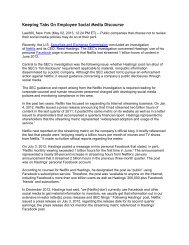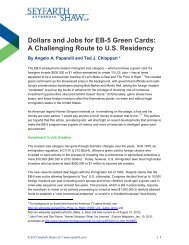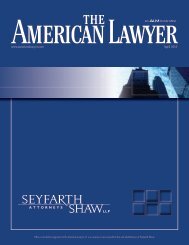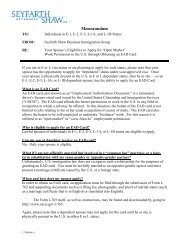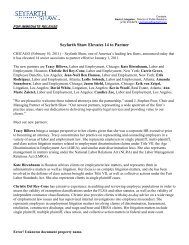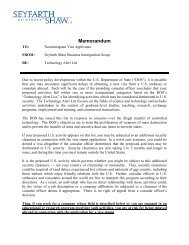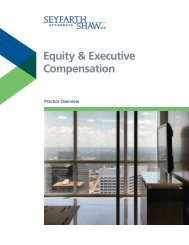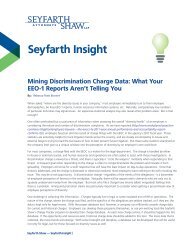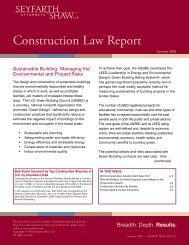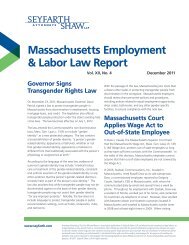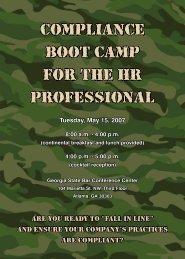Litigating California Wage & Hour and Labor Code Class Actions
Litigating California Wage & Hour and Labor Code Class Actions
Litigating California Wage & Hour and Labor Code Class Actions
Create successful ePaper yourself
Turn your PDF publications into a flip-book with our unique Google optimized e-Paper software.
XIV. <strong>Class</strong> Certification<br />
A. General Requirements<br />
In order to certify a class action, plaintiffs must show “the existence of an ascertainable<br />
class <strong>and</strong> a well-defined community of interest among the class members.” The community<br />
of interest requirement embodies three factors: (1) predominant common questions of law<br />
or fact, (2) class representatives with claims or defenses typical of the class, <strong>and</strong> (3) class<br />
representatives who can adequately represent the class.” 353 There must also be enough<br />
class members to make the effort worthwhile. These elements are referred to as<br />
ascertainability, commonality or predominance, typicality, adequacy, <strong>and</strong> numerosity.<br />
<strong>Class</strong> certification is most often defeated on commonality or predominance grounds, <strong>and</strong><br />
less often on the grounds of typicality, adequacy, ascertainability, <strong>and</strong> numerosity.<br />
In the past, some defendants resisted class certification by arguing that plaintiffs would not<br />
be able to establish liability on the merits. In 2000, the <strong>California</strong> Supreme Court formally<br />
rejected such a practice, holding that a trial court could not consider the factual or legal<br />
merits in deciding class certification, except to the (limited) extent that the merits affected<br />
the ascertainability of the class. 354 In other words, while it is appropriate for the trial court to<br />
examine the evidence closely to determine if the relevant class action factors have been<br />
met (e.g., predominance of common issues), the court may not deny class certification on<br />
the ground that the class claims ultimately lack substantive merit. 355<br />
However, as discussed in more detail below, courts must make necessary factual <strong>and</strong> legal<br />
inquiries regardless of whether they overlap with the merits, in order to ascertain whether<br />
the claims alleged are amenable to resolution on a class-wide basis. 356 Recent<br />
353<br />
354<br />
355<br />
356<br />
Richmond v. Dart Indus., Inc., 29 Cal. 3d 462, 470 (1981).<br />
Linder v. Thrifty Oil, 23 Cal. 4th 429 (2000). The procedure disallowed in Linder should be distinguished from a precertification<br />
motion for summary judgment as to the individual’s claims. Such a motion, if granted as to all named<br />
plaintiffs, effectively would defeat class certification because it would remove all adequate representatives. Allen v.<br />
Pacific Bell, 348 F.3d 1113, 1115 (9th Cir. 2003). Such a pre-certification summary judgment would not bind the class,<br />
however.<br />
See Brinker Restaurant Corp. v. Superior Court, 2012 WL 1216356 at * 7 (Cal. 2012) (“Presented with a class<br />
certification motion, a trial court must examine the plaintiff’s theory of recovery assess the nature of the legal <strong>and</strong> factual<br />
disputes likely to be presented, <strong>and</strong> decide whether individual or common issues predominate. To the extent the<br />
propriety of certification depends upon disputed threshold legal or factual questions, a court may, <strong>and</strong> indeed must,<br />
resolve them”); Bartold v. Glendale Fed. Bank, 81 Cal. App. 4th 816, 829 (2000) (“when the merits of the claim are<br />
enmeshed with class action requirements, the trial court must consider evidence bearing on the factual elements<br />
necessary to determine whether to certify the class”).<br />
Wal-mart Stores, Inc. v. Dukes , 131 S. Ct. 2541, 2551-52 (2011) (citing Gen. Telephone Co. of S.W. v. Falcon, 457<br />
U.S. 147, 102 S. Ct. 2364, 72 L. Ed. 2d 740 (1982)); see also Ellis v. Costco Wholesale Corp., 657 F.3d 970, 984 (9th<br />
Cir. 2011) (holding the district court erred by failing to conduct a “rigorous analysis” of the merits to determine whether<br />
the plaintiffs had established commonality under Rule 23); In re Hydrogen Peroxide Antitrust Litig., 552 F.3d 305, 318<br />
(3d Cir. 2008) (class certification requires “thorough examination” of factual <strong>and</strong> legal allegations; “rigorous analysis<br />
may include a preliminary inquiry into the merits” <strong>and</strong> consideration of “the substantive elements of the plaintiffs’ case in<br />
Seyfarth Shaw LLP | www.seyfarth.com <strong>Litigating</strong> <strong>California</strong> <strong>Wage</strong> & <strong>Hour</strong> <strong>Class</strong> <strong>Actions</strong> (12th Edition) 75



